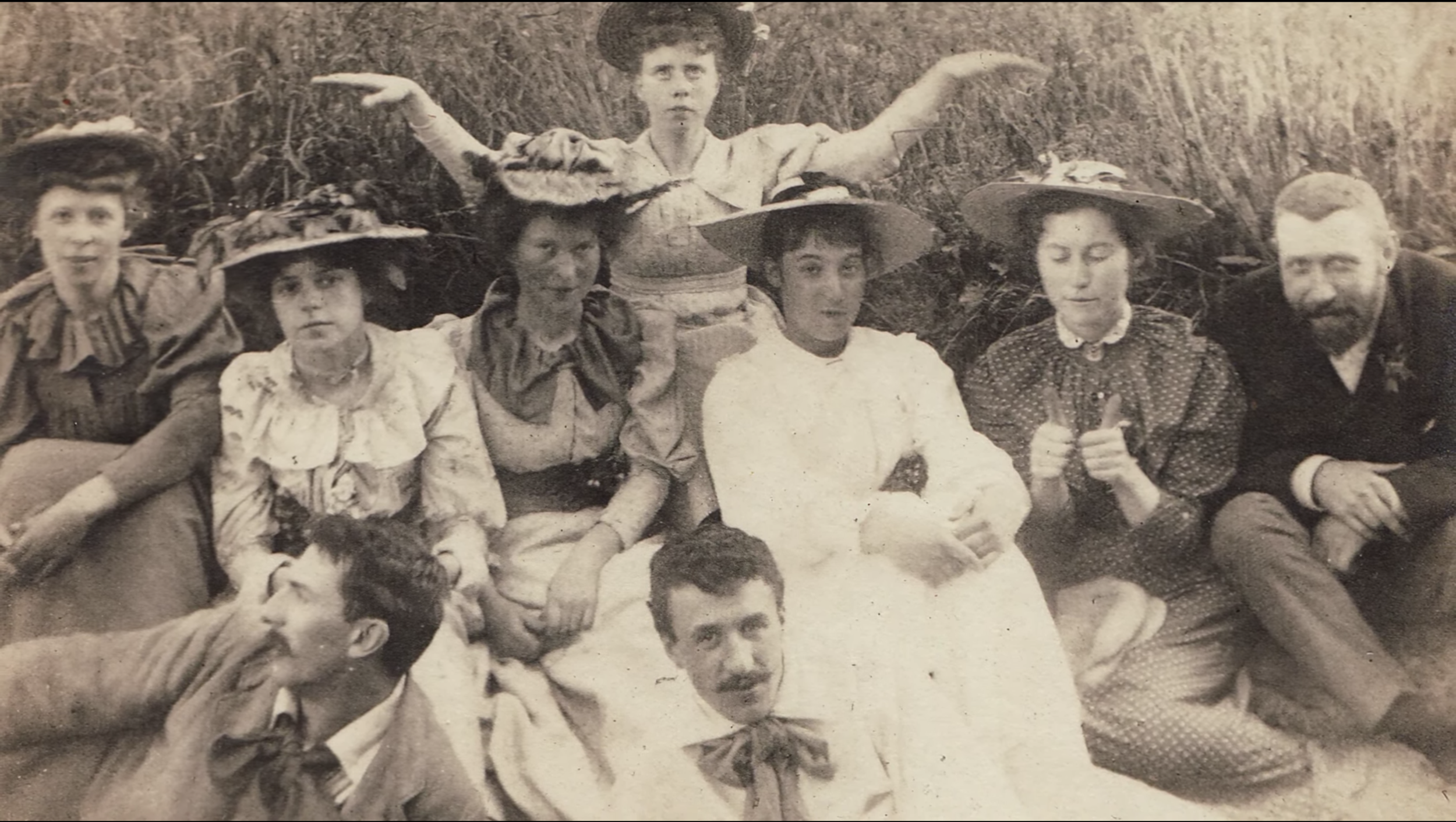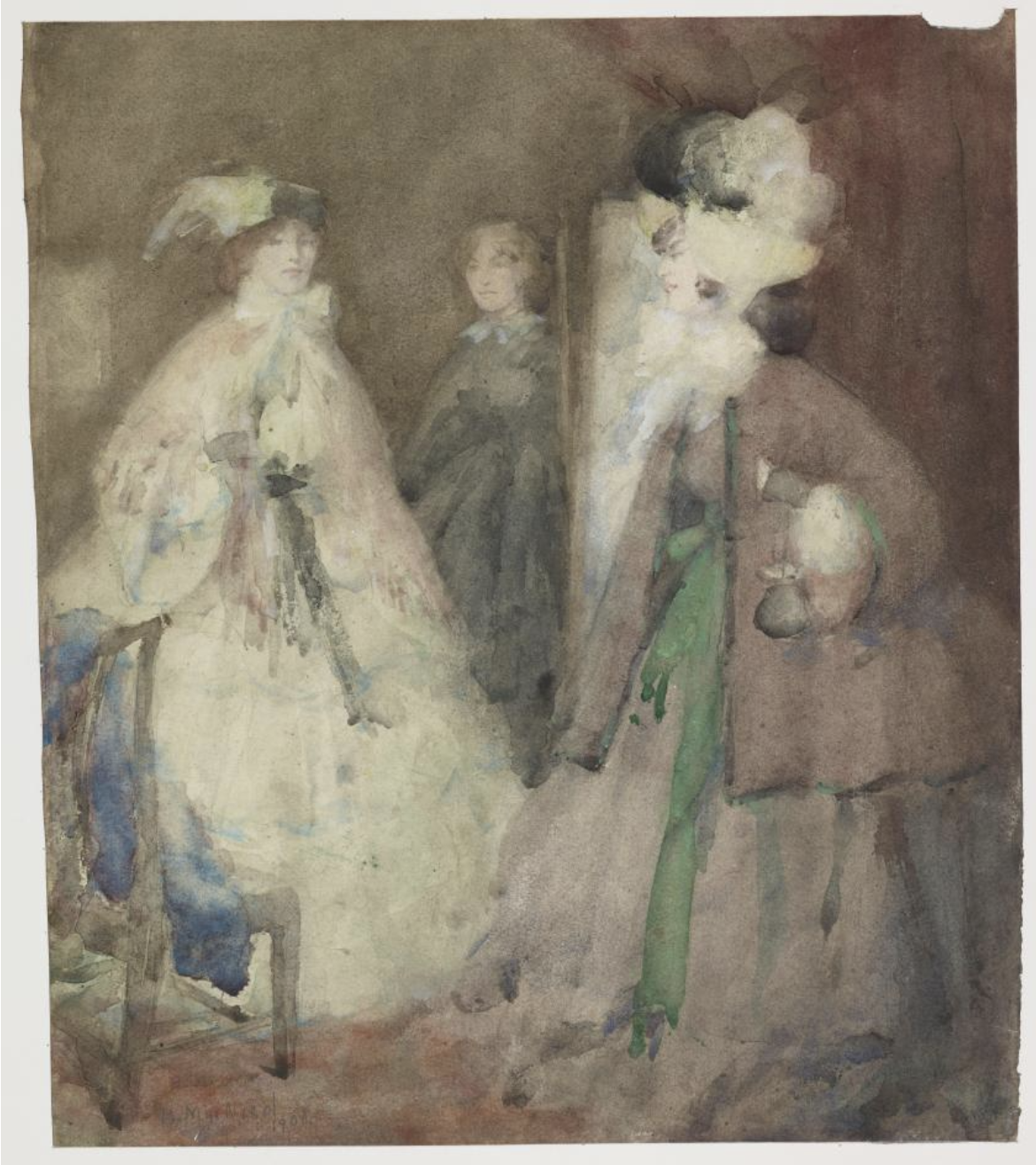Dear Scotland, Love the Glasgow Girls
By Ilaria Bevan
The Glasgow Girls (active from 1880-1920) are undoubtedly one of the most unrecognized groups of women artists in Western Art History.
Photograph of students at the Glasgow School of Art (known as ‘The Immortals’: Frances Macdonald, Margaret Macdonald, Katherine Cameron, Janet Aitken, Agnes Raeburn, Jessie Keppie, John Keppie, Charles Rennie Mackintosh, Herbert MacNair, c.1893.
Overshadowed by the Glasgow Boys, who were a very influential group of male artists working in the early 1880s, these women artists, despite their individual styles and materials and techniques, were fundamentally connected by their desire to create art, shared experiences and continued efforts to support one another and ought to be given proper recognition by Art Historians. Artists understood to be part of the Glasgow Girls group are as follows: Margaret Macdoland Mackintosh, Frances Macdonald Macnair, Helen Paxton Brown, De Courcy Lethwaite Dewar, Ann Macbeth, Annie French, Jessie Marion King, Bessie Macnicol and Stansmore Dean.
It was not until 1990 when Jude Burkhauser organised and curated the exhibition (and accompanying catalogue) Glasgow Girls: women in art and design 1880-1920 held in the Kelvingrove Museum in Glasgow that the group were given the recognition they deserved.
Even the name of the group was created unintentionally, and presumably without much attention. An essay written by William Buchanan featured in the catalogue for the Scottish Arts Council Exhibition of The Glasgow Boys organised in 1968 provides the source. Buchanan adopts the term ‘Glasgow Girls’ to merely illustrate that these women artists were the female equivalents to these well-known Glaswegian male artists. Its use here completely ignores the personal and professional complexity of the Glasgow Girls group and insinuates their inferiority to the Glasgow Boys.
But these women artists were so much more established and innovative than Buchanan dared to acknowledge.
During the late nineteenth and early twentieth centuries Glasgow was a booming commercial centre, quickly becoming one of the leading cities in the shipbuilding and textiles industries. This era of economic prosperity and urban growth provided abundant opportunities for artists and designers to learn about, create and exhibit art. This paved the way for the establishment of museums, libraries and art galleries and by the 1890s Glasgow had more civic amenities than any other city of its size. The city ultimately became a place where like-minded artists, patrons, writers and other creatives could meet and share ideas.
It was against this backdrop that Francis ‘Fra’ Newbery took over as headmaster of the Glasgow School of Art in 1885. Established only forty years earlier, the school offered classes in architecture, fine art and design but prioritised the two former modes of art and was primarily attended by men.
Fra Newbery and Jessie Newbery photographed in costume, late nineteenth or early twentieth century.
Under the leadership of Fra Newbery the school entered its golden years. He and his wife Jessie Newbery pioneered a more inclusive approach to art education that encouraged women artists and afforded design and decorative arts such as textiles, metalwork, ceramics, jewellery-making and embroidery the same status as painting and sculpture. These art forms had been previously ignored by art education systems due to their ‘feminine’ associations and the enduring perspective that they did not require the same level of skill and intellect as fine art. Consequently design departments that had been disregarded for so long finally flourished and provided the foundations for many women in the group to succeed professionally.
Many of the women who studied under Fra Newbery formed close friendships with one another and several returned to the school to teach in the departments that had previously encouraged their creative spirit - Jessie Marion King and Helen Paxton Brown shared a space at 141 Bath Street and Anne Macbeth joined Jessie Newbery as a teacher in the school’s embroidery department in 1902. This environment of friendship is perfectly expressed in the formation of the Glasgow Society of Lady Artists in 1882 and was a dedicated forum where women could promote their work.
Although the women are described under this blanket term ‘Glasgow Girls’, they are all incredibly different. For me, three women in particular stood out: Margaret Macdoland Mackintosh and Frances Macdonald Macnair, and Bessie Macintosh.
The Macdonald sisters are the most recognised women of the group as a consequence of their marriages to Charles Rennie Mackintosh and Herbert Macair, both of whom were prominent contributors to the development of the Modern Style (also known as British Art Nouveau) in Glasgow. Together they were known loosely as ‘The Four’ and came to represent the core of Glasgow style of art which was heavily influenced by the Arts and Crafts Movement, the Celtic Revival and Art Nouveau.
Margaret Macdonald Mackintosh, Gesso panel of a sleeping princess, 1902-3
This innovative, all-embracing style is perfectly illustrated in the design and decoration of Hill House (near Helensburgh, 1902-3). Although Charles is widely regarded to be the engineer behind this domestic masterpiece he correctly stated that ‘I had the talent, but she [Margeret] had the genius’. The genius professed by her husband is exhibited in the gorgeous gesso panel placed above the drawing room fireplace and also the silk embroidered hangings that frame either side of the bed in the main bedroom.
Jessie Newbery, ‘Sensim Sed’ cushion, c.1900.
Incidentally, the recurring rose motifs that feature on the wallpaper and in the light fixtures throughout the house were not designed by Charles, but instead were conceived by the embroidered and freehand-cut designs of Jessie Newbery, demonstrated in her ‘Sensim Sed’ cushion.
Frances Macdonald Macnair, Bow, c.1910.
Frances herself was a wonderful artist of equal standing as her sister, which is illustrated in the small painting Bows created in c.1910. Using a variety of materials - pencil and watercolour heightened with touches of bodycolour with scratching out on vellum - Frances plays with the distinctive Art Nouveau style of illustrator Aubrey Beardsley to depict an ethereal female figure. Bows themselves feature prominently in the work and highlight the femininity and extravagant dress of women at the time, but also seem to emphasise the woman’s body as a sensual and beautiful entity.
Bessie Macnicol, Three Ladies of Fashion, 1900.
Bessie MacNicol was an extremely enigmatic artist and was one of the two most important painters in the Glasgow Girls, the other being Stansmore Dean. Macnicol, who was a student at the Glasgow School of Art from 1887 to 1892, was encouraged by Fra Newbery to continue her studies which she did at the Académie Colarossi between 1893 to 1894. Her paintings are heavily influenced by the style of Edward Atkinson Hornel (one of the Glasgow Boys) whom she painted a portrait of in 1896. Her watercolour painting, Three Ladies of Fashion encompasses Hornel’s use of colour and texture which is demonstrated in her virtuoso blending of mauves and browns with bright green and blue motifs to create layers of paint that emulates the drapery of the fabric worn by the women.
Much like the recent virtual exhibition held by The Fleming Collection from 5 June to 12 September 2020, this article only scratches the surface of the true brilliance of the Glasgow Girls. When measured against the vast changes in Western art education and women’s rights at that time, the efforts of the Glasgow Girls is enormously inspiring and they will undoubtedly continue to be an inspiration to women artists today and for generations to come.
Bibliography:
Hill House. “The House.” Accessed 15 November, 2021. https://www.nts.org.uk/visit/places/the-hill-house/highlights/the-house?lang=.
National Gallery of Scotland. “Bessie Macnicol.” Accessed 15 November, 2021. https://www.nationalgalleries.org/art-and-artists/21808.
National Gallery of Scotland. “Scotland’s Art | The Glasgow Girls.” Filmed January, 2021, video, 5:43, https://www.youtube.com/watch?v=ke0nV-xa1mc&ab_channel=nationalgalleries.
National Gallery of Scotland. “Frances Macdonald Macnair.” Accessed 15 November, 2021. https://www.nationalgalleries.org/art-and-artists/179991.
Tanner, Ailsa. “MacNicol [married name Frew], Elizabeth [Bessie] (1869–1904), painter.” Oxford Dictionary of National Biography. 23 Sep. 2004; Accessed 15 Nov. 2021. https://www.oxforddnb.com/view/10.1093/ref:odnb/9780198614128.001.0001/odnb-9780198614128-e-70511.
The Scottish Gallery. “The Glasgow Girls & Boys with James Knox.” Filmed December 2020, video, 29:25, https://www.youtube.com/watch?v=uEKOsRG0dA4&ab_channel=TheScottishGallery.






